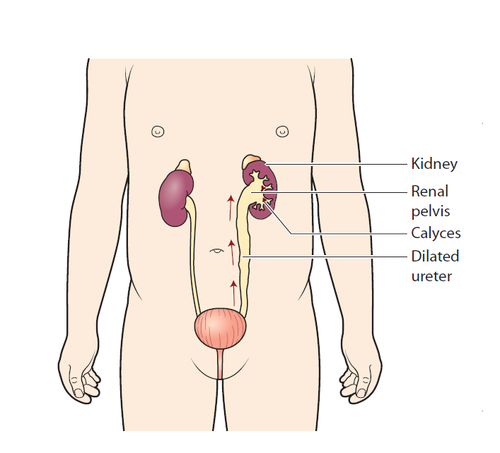VUR – how it happens
How we pass urine
Urine is made in each kidney and then passes through its ureter to the bladder. The bladder fills up with urine, like a balloon. When it is full, it sends signals to the brain that ‘tell’ the bladder muscles to push urine out through the urethra. This is how we pass urine (wee).
As most people urinate (wee), the end of each ureter that goes into the bladder squeezes tight. It acts like a one-way valve – urine can go into the bladder, but cannot leave the bladder back up the ureter.
How VUR happens
In VUR there is a problem with the way one or both ureters enter the bladder. The ‘valve’ does not work. This is usually present at birth.
As children with VUR urinate, some urine refluxes (goes back up) one or both ureters, and may reach the kidney.
After urinating, this urine settles back into the bladder. In severe VUR, this means the bladder is never completely empty.
The name means:
- vesico – to do with the bladder
- ureteral (or ureteric) – to do with the ureter
- reflux – a backward flow.
Grades
VUR has 5 grades. These depend how far urine refluxes up the ureter, and whether it is held up in the kidney. Grades 1 and 2 are mild, and Grades 3, 4 and 5 are more severe.

- Grade 1 – urine refluxes into the ureter only.
- Grade 2 – urine refluxes into the kidney (this is in the renal pelvis, the area of the kidney nearest the ureters, which normally collects urine after it is made in the kidneys).
- Grade 3 – urine refluxes into the kidney, and the renal calyces, the areas of the kidney that collect urine after it is made, start to dilate (get larger).
- Grade 4 – urine refluxes into the ureter, and the renal calyces are more dilated.
- Grade 5 – urine refluxes into the ureter, and the renal pelvis is severely dilated – the entire kidney looks larger.
Some children stay at the same grade for a long time, and a few get worse (go to a higher grade). The VUR gets better in more than half of children in the first few years of life.
One or both sides
- Urine may go back up one ureter and towards one kidney only – this is called unilateral VUR (‘unilateral’ means one side).
- Or, urine may go back up both ureters and towards both kidneys – this is called bilateral VUR (‘bilateral’ means two sides). If VUR is bilateral and high grade, it is more likely that the bladder is never completely empty.
VUR – causes
VUR is not caused by anything that the mother does during her pregnancy. It sometimes runs in families. If one of your children has VUR, your doctor may recommend that his or her brothers and sisters are also tested, especially if they have any complications such as frequent urinary tract infections (UTIs).
No known cause
VUR may happen on its own, though it is not always known why this happens. This is called primary VUR.
Known causes
VUR may be caused by, or happen with, another problem in the urinary system that makes it difficult to pass urine. This is called secondary VUR. Most of these problems are present at birth.
- Posterior urethral valves (PUV) – a blockage in part of the urethra (nearest the bladder) that happens in some boys.
- Neuropathic bladder (or neurogenic bladder) – a problem with the nervous system (including the brain), which affects how the bladder works. These children are unable to control how their bladder works, and may dribble urine or have bladder spasms.
- Ureterocele – the ureter dilates (swells) where it enters the bladder because the opening is very small. This is often found where a kidney and ureter develop in two parts (duplex kidney) – in these cases, sometimes one of the ureters has a ureterocele and one has reflux.
Other problems
VUR may also happen with other kidney problems that develop while the baby is growing in the womb. These include renal dysplasia or renal hypoplasia, when one or both kidneys do not fully develop and are often smaller than usual.
Children may also be at risk of UTIs in the affected kidney, which may cause further damage.
Reflux nephropathy – causes
Reflux nephropathy is kidney scarring (damage) that is seen with VUR. This develops rarely in children with VUR who get kidney infections (pyelonephritis), which may cause scars on the kidneys.
One or both sides
- There may be scars on one kidney only – this is called unilateral reflux nephropathy.
- Or, there may be scars on both kidneys – this is called bilateral reflux nephropathy.